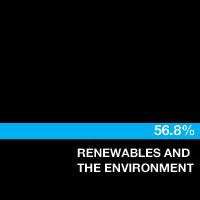Today’s infographic comes from the Smart Jobs special report at Wired (click here to view the full version). And should provide America’s battered workforce some valuable insights.
At 56.8 percent, the renewables and environment category saw the biggest percentage gains among seven million U.S. job hoppers on LinkedIn during the past five years. (On a side note, it seems to shed some light on how LinkedIn groups its members career choices.)
Here’s a snippet from the article that perfectly captures the essence of the evolving American employment picture. Incidentally, it also describes the kind of work that seekers of green jobs can expect to find.
Smart jobs tend to scramble the line between blue-collar and white-collar. Their titles tend toward the white (technician, specialist, analyst), but the underlying industries often tend toward the blue, toward the making of physical stuff. Smart jobs can involve factories and machines, plastics and chemicals, but operating those instruments and manipulating those materials demands far more brains than brawn. Even though some of these jobs are nominally in old-fashioned industries, visit the factories and shops and fields and you’ll find that these industries are in the process of being utterly transformed.
I also encourage you to point your browser to another infographic in the series,
The Emerging Epicenters of High Tech Industry, for a look at where job growth percolating and in which industries. For instance, how about Fort Collins, Colorado is automotively-inclined greentechies? Maybe Reading, Pennsylvania for next-gen car batteries?
Take a look. Heck, it might help you land that smart, green job you’re looking for.


[…] of the day: Smart, Green Jobs — ecoINSITE Posted on June 6, 2011 by jwalker This is from "green Jobs" – Google Blog Search: Wired's Smart Jobs special report helps shed some light for green job […]